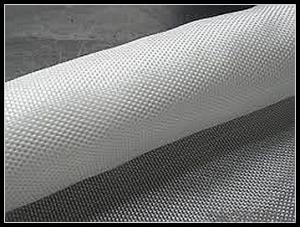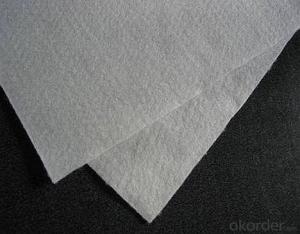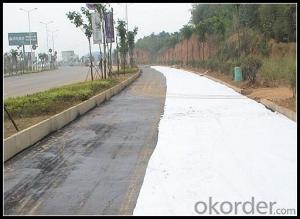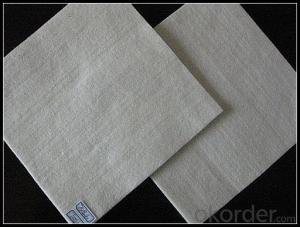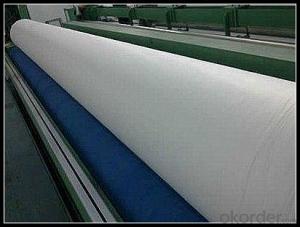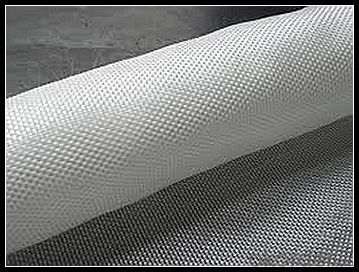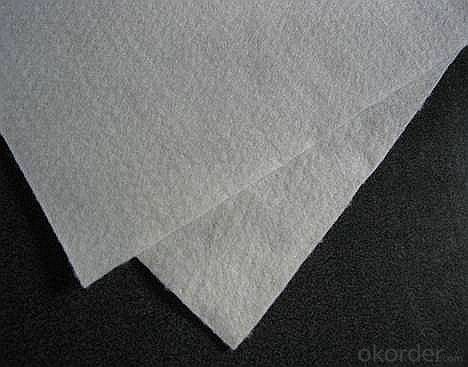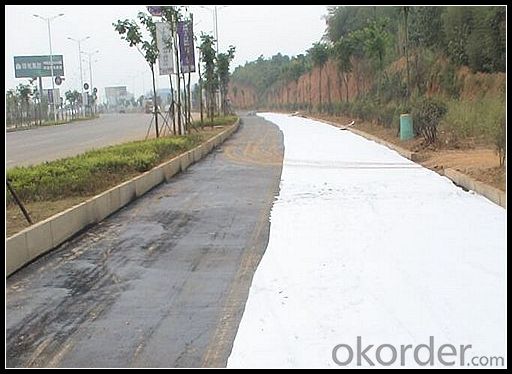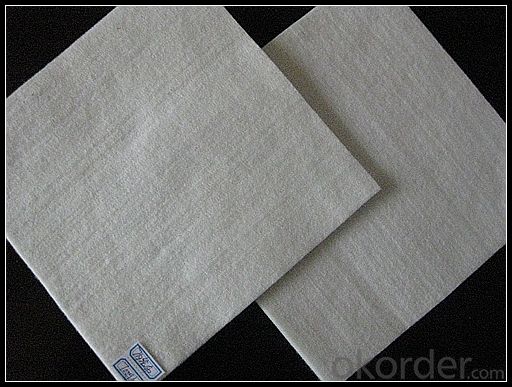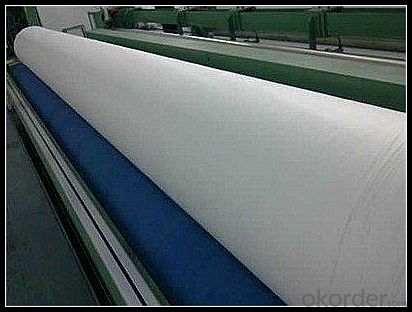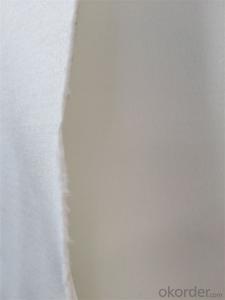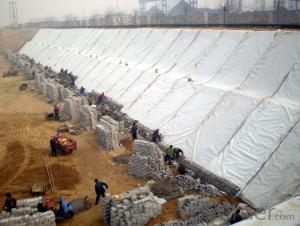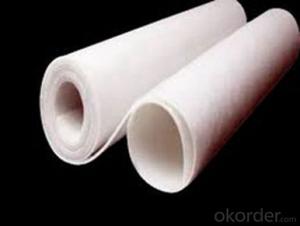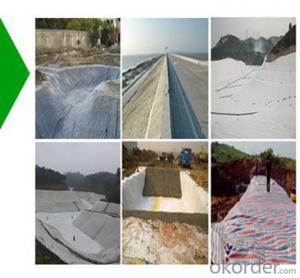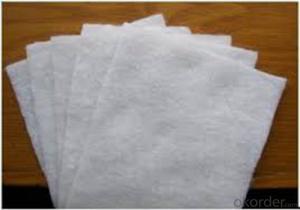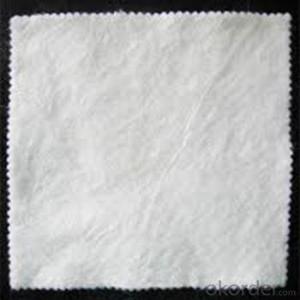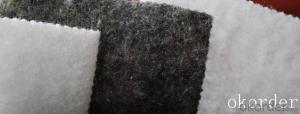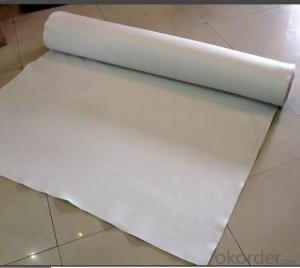Geotextil No Tejido 200 Gr/M2 Short Fabric Non-Woven Geotextile Road Building Constructive Felt Fabric with Highest Quality
- Loading Port:
- China main port
- Payment Terms:
- TT OR LC
- Min Order Qty:
- 1000 m²
- Supply Capability:
- 1000000 m²/month
OKorder Service Pledge
OKorder Financial Service
You Might Also Like
Specification
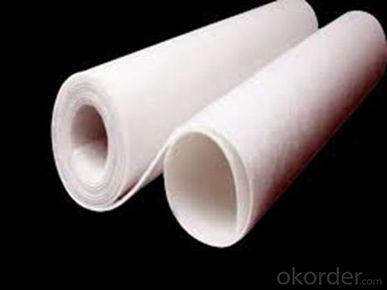
Length:
Customer Requirment
Weight:
100g/m2-1500g/m2
Color:
White, Black, etc
Application:
Water Conservancy
Material:
PP(polypropylene) PET (polyester)
Geotextile-Roads
Geotextiles provide three main functions to the roads:
Separation
Woven Geotextile and non woven Geotextiles provide long-term separation of the aggregate base from the subgrade soil. By separating these two materials, the Geotextile maintains the original thickness of the roadway aggregate. This is the most important Geotextile function for roads, particularly where the road is being constructed on weak subgrade soils.
Filtration and Drainage
Geotextile allows the ground water to pass into the subsurface drain without eroding the soil and helping the ground from deterioration making the life of the roads very long.
geotextile fabric
permeability,filtration,easy for construction
ISO and CE certificate
Good quality and competitive price
Our Service
Quality assurance
1.On a regular basis or as per your request,we entrust national testing agencies to conduct quality inspections
2. Strictly in accordance with the ISO9001-2008 international quality system standard,we monitor and manage the whole process throughout production,quality testing,and measurement to ensure product quality
3. For quality-related construction delay or substandard construction(except for damage or losses due to customer’s responsibility or irresistible natural disasters),we have refunding,replacement,and repair services.We will respond to customers’ feedbacks on quality issues within 24 hours.
Packaging & Shipping
Packing: PLASTIC FILM INSIDE, AND WOVEN BAG OUTSIDE
Shipping: About 15 days after receipt the deposit
FAQ:
Q: What kind of payments does jenor support?
A: T/T, L/C, Cash are accepted.
Q: Do you charge for the samples?
A: Accordeing to our company policy, the samples are free, we only charge the freight fee. And we will return the freight fee during the next order.
Q: Can you produce according to customers' design?
A: Sure, we are professional manufacturer, OEM and ODM are both welcome.
Q: Do you have other products?
A: Yes, please check the pictures:
- Q: After the laying of drainage board and then need to lay a layer of geotextile it?
- Yes, from the role of filtration, over the water, but to prevent clogging, I professional production
- Q: How do geotextiles help in preventing sinkhole formation?
- Geotextiles help in preventing sinkhole formation by providing reinforcement and stabilization to the soil. They act as a barrier, preventing the migration of soil particles and reducing the potential for erosion. This reinforcement helps to maintain the integrity and strength of the soil, minimizing the risk of sinkhole formation.
- Q: Can geotextiles be used for reinforcement in landfills?
- Yes, geotextiles can be used for reinforcement in landfills. They are often used as a separation layer between different soil layers, providing stability and preventing the mixing of materials. Geotextiles also help in enhancing the overall strength and performance of the landfill structure by distributing loads and reducing the potential for erosion or piping.
- Q: Can geotextiles be used in pond liner applications?
- Yes, geotextiles can be used in pond liner applications. They are often used as an additional layer in pond liners to provide reinforcement, filtration, and separation. Geotextiles help prevent soil erosion, improve water quality, and enhance the overall durability and performance of the pond liner system.
- Q: Geotextile exports Nordic need certification
- Production standards geotextile, geomembrane, composite geomembrane. Certificate, test report
- Q: How do geotextiles help with reinforcement of soil slopes?
- Geotextiles help with the reinforcement of soil slopes by providing a stable and strong barrier that prevents soil erosion. They act as a protective layer, distributing the weight and forces evenly, enhancing the stability of the slope. Additionally, geotextiles separate the soil layers, preventing intermixing and promoting drainage, which further contributes to the reinforcement of the slope.
- Q: Can geotextiles be used in shoreline protection projects?
- Yes, geotextiles can be used in shoreline protection projects. Geotextiles are often utilized in coastal erosion control and shoreline stabilization efforts as they can help to prevent soil erosion, control sediment movement, and enhance the stability of shoreline structures.
- Q: What are the maintenance requirements for geotextiles?
- The maintenance requirements for geotextiles generally involve regular inspection and cleaning. Regular inspection helps identify any damage or wear, which can then be repaired or replaced. Cleaning may involve removing any debris or sediment that has accumulated on the geotextiles to maintain their functionality and prolong their lifespan.
- Q: What is the role of the laying of geotextiles at the bottom of the grassland?
- From the soil and soil, fixed slope protection, anti-erosion, anti-filter (over the water, but soil) and other effects, I professional production geotextile, geomembrane and other products, wish smooth
- Q: What are the advantages of using geotextiles in shoreline stabilization?
- Geotextiles offer several advantages in shoreline stabilization. Firstly, they act as a barrier, preventing erosion caused by waves, tides, and currents. They effectively hold the soil in place, reducing the risk of land loss and maintaining the integrity of the shoreline. Secondly, geotextiles are permeable, allowing water to pass through while retaining the soil particles, which helps in maintaining a stable and balanced ecosystem. Additionally, they are durable and resistant to UV degradation, ensuring a long lifespan and reducing the need for frequent maintenance. Lastly, geotextiles are easy to install and cost-effective compared to traditional methods, making them a practical choice for shoreline stabilization projects. Overall, geotextiles provide a sustainable and efficient solution to protect and enhance coastal areas.
Send your message to us
Geotextil No Tejido 200 Gr/M2 Short Fabric Non-Woven Geotextile Road Building Constructive Felt Fabric with Highest Quality
- Loading Port:
- China main port
- Payment Terms:
- TT OR LC
- Min Order Qty:
- 1000 m²
- Supply Capability:
- 1000000 m²/month
OKorder Service Pledge
OKorder Financial Service
Similar products
Hot products
Hot Searches
Related keywords
